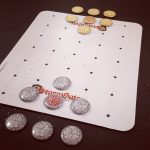
![IMG_20180613_013616_475[1] StormGate Classic with stones](https://adlinteractive.com/wp-content/uploads/2018/06/IMG_20180613_013616_4751.jpg)
No. of Players: 2
Playtime: 5-15 minutes
Age: 8+
Type: Family
Published: n/a
Designer: CK Leach
Artist: CK Leach
Mechanisms: Capture the Flag, Chess
Expansion: n/a
How to Play StormGate
Description
Declaration of War or Maintaining the Peace – Choose your adventure
You, a tireless knight, and your 6 men are entrusted to travel across the lands and deliver a most urgent message. The deadline is at hand and only you and your men are trusted to inform the neighbouring kingdom of their yield to conflict. Deliver your king’s wishes and be heralded the greatest knight in the land.
Or maybe you fancy a greater threat. Your kingdom is in peril. A coup has formed within your ranks and your king’s life is in grave danger. You and your trusted 6 must warn thy majesty by breaking through the gates and informing him of the impending treachery. Only you have the power to save the kingdom from ruin.
StormGate is a grid game that is played on a 4×6 grid. Each player has 8 pieces (stones); 6 soldiers, 1 knight and 1 king. Only 3 soldiers and the knight are allowed on the board at one time. The king is reserved for the King’s Court version of the game.
The general rules are simple:
- Each player can make two moves, 1 per soldier, or 2 for the knight.
Only forward or lateral movements allowed. - No diagonal or backward movement by soldiers. Knight can do so only after passing the river.
- Cannot move the same soldier back from where it was on the following turn
- Kill an opponent’s piece by taking their space. Kills are not mandatory.
- If a gate is not occupied, a player can use 1 turn and respawn a soldier from their sideline.
Legal moves are made in a forward or lateral motion. No piece can move backwards on the field – with the exception of the knight only after passing the river (halfway point). On opposite ends of the board, on the home line is your opponents Gate. The idea of the game is to get your knight to your opponents gate.
Each player can move a single soldier 1 space, or the knight 2 spaces. Soldiers in an adjacent row can leap frog forward or sideward for both offensive and defensive strategies. Beginners will surely see that it resembles checkers and chess in a way, so almost everyone will get the hang of it right off the bat.
Development
The current game today did start out much simpler in design and concept. Storm the Gate was the original name for this game. Back in January of 2013 I was inspired to create a medieval themed game on a traditional board. Similar to chess in a lot of ways this game derived from a modification of mini (micro) chess variants. I figured reducing the space and the amount of pieces would make the game more intense while keeping the strategy. Later on, around the time I was showcasing this for the first time at a convention, I was told by a veteran chess member and referee with the Ontario Chess Association that this game is solvable and wouldn’t be as challenging to advanced chess players. I took note, and agreed. It wasn’t for the heavily involved chess player. It is a thematic chess-like experience. He took note, and agreed.
Moving on from the 2014 show I’ve had a lot of good and bad feedback about the game. I expanded my board from a 4×4 to a 4×6 grid for more moves, and also added the river rule where the knights can move backwards but cannot pass the river. Also, the addition of 3 more soldiers extended the game play and provided players with a chance to strategically lose men on the field. Then King’s Court came.
King’s Court (KC) is the continuation of Messenger’s Quest (MQ). In KC, one players is the kingdom and the other is the assassin. Basically a castle defense game. KC uses all the same rules as MQ but this time all 8 pieces are on the board. Then a light switched on. KC could be the second half to the game as a whole. First half would be MQ, but whomever wins that game then plays the assassins in the second part. The soldiers lost in MQ do not come back in part two, making the KC very fast and very open. But then I thought, you know what? People might not want to play KC with limited men. It may seem like a handicap. So I figured each can either play with exactly how many soldier that are still alive OR both play with the remaining amount of men. That would prove to be interesting. Plays into the strategy that your soldiers in MQ aren’t disposable.






![IMG_20180613_013616_475[1] StormGate Classic with stones](https://adlinteractive.com/wp-content/uploads/2018/06/IMG_20180613_013616_4751-150x150.jpg)


